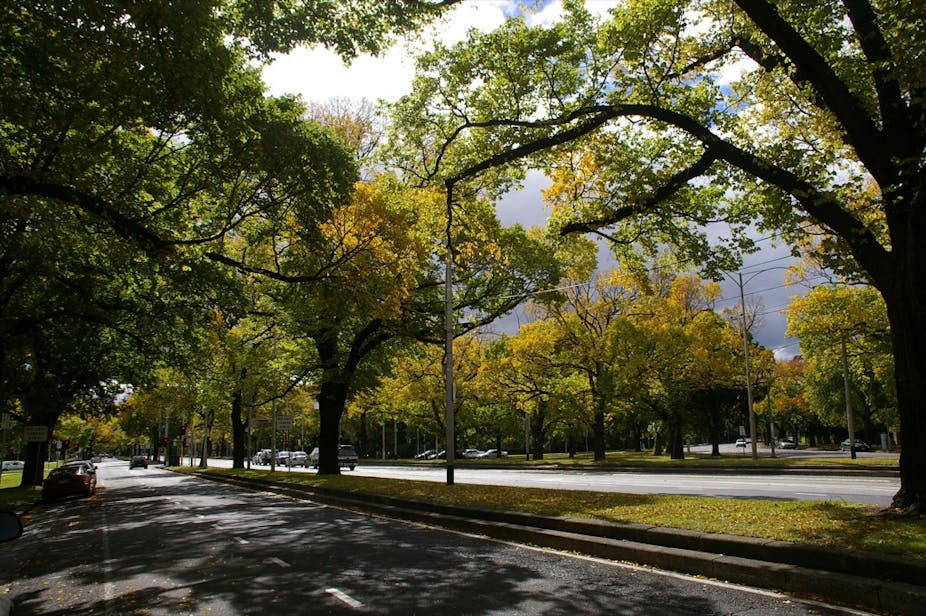When you look out of your window in the morning, how many trees do you see? Your answer might depend on what suburb you live in.
As you go further from the city centre, the amount of tree cover in a suburb decreases, while the amount of green space, such as lawns and parks, increases.
In Melbourne, for every 10 kilometres you travel from the city centre, the tree cover drops by more than 2%. That means Melbourne’s inner suburbs might have more than 15% cover, but an outer suburb could have less than 10%.
A 5% fall in urban tree cover can lead to a 1-2C rise in air temperature, leaving these communities more exposed to extreme heat. This really matters for community health and well-being, especially for the vulnerable among us – the elderly, young children and those with existing health issues.
There’s also mounting evidence that exposure to greenery and nature improves community mental health and well-being.
So, what is driving this suburb tree cover inequality?
No single answer
This is not about a lack of green space, nature strips or roads to plant into. These trees are simply missing from our outer suburbs.
They are missing from backyards — partly because newer houses in the outer suburbs take up more space — and they are missing from the streets.
The recent property boom has also brought with it a gradual “thinning out” of tree cover in established suburbs, as residential plots are sub-divided.
But does it matter where these trees are planted in our cities? Well, yes it does if we want the benefits that tree cover provides including cooler temperatures.
It also matters for our weekly household budget, for the lucky among us that have an air-conditioner. This in turn, affects the electricity demand of the city as a whole.
Disturbingly, but perhaps not unexpectedly, suburbs with the least tree cover are the most socially disadvantaged and have the lowest levels of tertiary education.
In Melbourne, suburbs with a higher proportion of tertiary educated residents have more trees shading paved roads and walkways. This could be driven by residents with a higher level of education lobbying their local council more for trees to be planted – but not likely.
The relationships between education, household income, property values, council rates and suburb tree cover are complex and don’t necessarily indicate causality. But tree canopy inequity does exist in our cities, and we need to first identify where this inequity intersects with social and economic disadvantage.
Once we know this, our tree planting efforts can be better targeted to increase the resilience of our most vulnerable communities.
Taking steps to grow tree cover
Cities that set targets to increase their tree cover might be swimming against the tide, unless the removal of trees from private and public space during development is regulated. This can be done, and has been done overseas in several cities such as in Seattle, Berlin, Toronto and Singapore.
Despite the availability of more and more satellite data on tree cover, there have been no published studies of tree cover change over time in Australian cities.
Still, chasing a percentage increase in overall tree canopy cover within a city may not necessarily address the huge inequality in tree cover distribution. We need to identify which neighbourhoods within a city have the least tree canopy cover and target those as a first priority.
We also need to engage with residents of those neighbourhoods to achieve acceptance and ultimately ownership of any tree planting efforts. Assessments of tree cover and community engagement at a whole of city level won’t achieve this. We need to assess tree cover, and engage with communities, in a more targeted way.
Neighbourhoods with the fewest trees shading roads and pavements should also be targeted, because they will get the greatest cooling benefit from planting more trees.
There is huge variation in tree canopy cover within our cities. Tree cover in the suburbs of one city can range from less than 10% cover to more than 50%.
Cities across Australia are now setting ambitious targets to increase their urban tree canopy cover.
The City of Melbourne aims to increase tree cover by 75% before 2040, the City of Sydney by 50% before 2030, and the City of Brisbane is targeting tree cover for bike and foot paths.
The federal government is also aiming to plant 20 Million Trees by 2020. So, it’s clear that there is going to be a lot of tree planting in our cities over the coming years.
Addressing tree cover inequality in Australian cities is not only an issue for local governments. It’s an issue that should involve the local community itself, as well as state and national governments. As one of the world’s most urbanised nations, we need to ensure that everyone is resilient to the mental pressures of urban living and the hazards of heat waves.
Lachie Alexander, Mohamed Nizam and Kate Denver-Stevenson, students of Stephen Livesley at The University of Melbourne, also contributed to this article.

